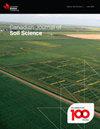北方森林向农业的土地转换对土壤健康指标的影响
IF 1.5
4区 农林科学
Q4 SOIL SCIENCE
引用次数: 0
摘要
摘要气候变化为农业向北扩展到北方森林创造了机会。将林地转变为农业用地通常会导致有机质(OM)的显著损失,从而影响土壤健康(SH)。本研究的目的是评估土地转换对SH指标的影响,并使用土壤健康综合评估(CASH)框架将这些指标的测量纳入评分中,以评估土地转换效果。本研究还测量了总碳和总氮。土壤(0–5和5–15厘米)是从安大略省雷霆湾附近的六个奶牛场采集的,其中包括一片成熟的森林,这片土地50年前从森林转为农业。土地转化导致高锰酸盐可氧化碳、湿集料稳定性、土壤呼吸以及OM、高压釜柠檬酸盐可提取蛋白质、总氮和总碳的浓度显著下降。转化为农业的土壤中较低的CASH分数被解释为SH的下降,但分数以及土壤有机质(SOM)浓度仍然很高(CASH=80;OM=6%)。转换后没有时间的影响,这表明SH的任何降解都发生得很快,并且与SOM的下降密切相关。本文章由计算机程序翻译,如有差异,请以英文原文为准。
The impact of land conversion from boreal forest to agriculture on soil health indicators
Abstract Climate change is creating opportunities for agricultural expansion northward into the boreal forest. Converting forested land to agricultural land generally results in significant losses of organic matter (OM), which can impact soil health (SH). The objectives of this study were to assess the effects of land conversion on indicators of SH and to use the Comprehensive Assessment for Soil Health (CASH) framework to integrate measures of these indicators into a score to evaluate land conversion effects. Total carbon and nitrogen were also measured in this study. Soils (0–5 and 5–15 cm) were collected from six dairy farms near Thunder Bay, ON, that included a mature forest, a field converted from forest to agriculture <10 years ago and a field converted from forest to agriculture >50 years ago. Land conversion resulted in significant declines in permanganate oxidizable carbon, wet aggregate stability, soil respiration, and concentrations of OM, autoclave citrate extractable protein, total nitrogen, and total carbon. Lower CASH scores in the soils converted to agriculture are interpreted to represent a decline in SH but the scores, along with soil organic matter (SOM) concentrations, remain high (CASH = 80; OM = 6%). There was no effect of time since conversion, suggesting that any degradation to SH happens quickly and is closely tied to declines in SOM.
求助全文
通过发布文献求助,成功后即可免费获取论文全文。
去求助
来源期刊

Canadian Journal of Soil Science
农林科学-土壤科学
CiteScore
2.90
自引率
11.80%
发文量
73
审稿时长
6.0 months
期刊介绍:
The Canadian Journal of Soil Science is an international peer-reviewed journal published in cooperation with the Canadian Society of Soil Science. The journal publishes original research on the use, management, structure and development of soils and draws from the disciplines of soil science, agrometeorology, ecology, agricultural engineering, environmental science, hydrology, forestry, geology, geography and climatology. Research is published in a number of topic sections including: agrometeorology; ecology, biological processes and plant interactions; composition and chemical processes; physical processes and interfaces; genesis, landscape processes and relationships; contamination and environmental stewardship; and management for agricultural, forestry and urban uses.
 求助内容:
求助内容: 应助结果提醒方式:
应助结果提醒方式:


